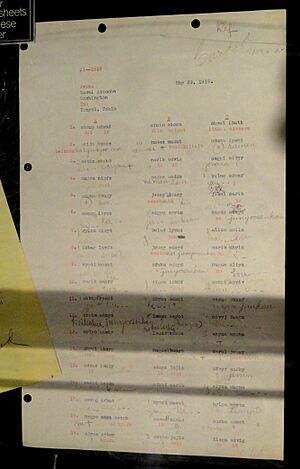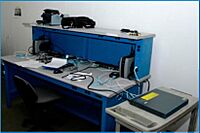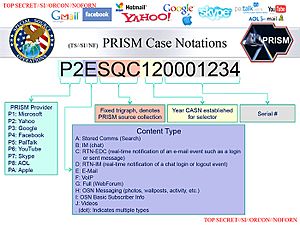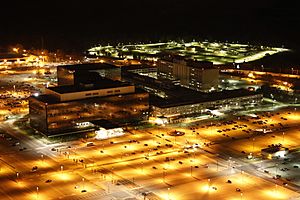National Security Agency facts for kids
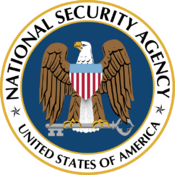
Seal of the National Security Agency
|
|

Flag of the National Security Agency
|
|
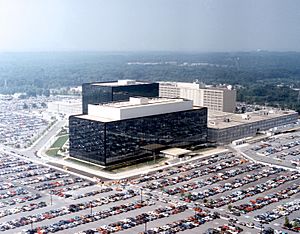 The NSA headquarters building in Fort Meade, Maryland, around 1986. |
|
| Agency overview | |
|---|---|
| Formed | November 4, 1952 |
| Preceding agency |
|
| Headquarters | Fort Meade, Maryland, U.S. (39°6′32″N 76°46′17″W / 39.10889°N 76.77139°W) |
| Motto | "Defending Our Nation. Securing the Future." |
| Employees | Classified (est. 30,000–40,000) |
| Annual budget | Classified (est. $10.8 billion, 2013) |
| Agency executives |
|
| Parent agency | Department of Defense |
The National Security Agency (NSA) is a top-secret intelligence agency for the United States government. It is part of the Department of Defense. The NSA's main job is to listen to and gather information from around the world. This is called signals intelligence (SIGINT), and it includes monitoring things like phone calls, emails, and internet activity.
The NSA also has the important task of protecting the U.S. government's own secret communications and computer systems from being spied on by others. To do its job, the NSA often works in secret. It is one of the largest U.S. intelligence agencies, with tens of thousands of employees.
The agency started as a small group that decoded secret messages during World War II. President Harry S. Truman officially created the NSA in 1952. Over the years, the NSA has been involved in many important historical events. It has also faced criticism for some of its secret programs, especially after a former contractor named Edward Snowden shared secret documents with the public in 2013. These documents showed that the NSA was collecting huge amounts of data from people all over the world, including American citizens.
Contents
History of the NSA
How the NSA Began
The story of the NSA starts back in 1917, during World War I. The U.S. government created a special unit to break secret codes used by other countries. This group was called the Cipher Bureau. After the war, it continued its work in New York City, disguised as a regular company. This early version of the agency was known as the Black Chamber.
The Black Chamber was very successful. It helped American diplomats during the Washington Naval Conference by reading the secret messages of other countries, including Japan. However, in 1929, the U.S. Secretary of State, Henry L. Stimson, shut it down. He famously said, "Gentlemen do not read each other's mail."
World War II and the Cold War
During World War II, the need for code-breaking was more important than ever. The U.S. Army created the Signal Intelligence Service (SIS) to intercept and understand messages from the Axis powers. After the war, this group was reorganized and eventually, in 1949, became the Armed Forces Security Agency (AFSA).
However, the AFSA wasn't very good at coordinating with other government agencies like the Central Intelligence Agency (CIA). So, in 1952, President Harry S. Truman ordered a change. The AFSA was renamed the National Security Agency (NSA) and given the power to oversee all U.S. code-breaking and signals intelligence. The NSA's existence was kept secret from the public for many years. People in the intelligence community joked that NSA stood for "No Such Agency."
The Vietnam War and Public Scrutiny
During the Vietnam War in the 1960s and 1970s, the NSA played a key role. It provided intelligence that led to increased U.S. involvement in the war. The agency also became part of a secret program called "MINARET," where it monitored the phone calls of Americans who were against the war, including famous leaders and journalists. This was later found to be improper.
In 1975, a special U.S. Senate group called the Church Committee investigated America's intelligence agencies. The committee discovered that the NSA had been spying on American citizens, which led to new laws like the Foreign Intelligence Surveillance Act of 1978. This law was created to limit the government's power to spy on its own people.
The Digital Age and the War on Terror
After the terrorist attacks of September 11, 2001, the NSA's mission grew dramatically. The agency began to use new technology to monitor the internet and cell phones to find terrorists. This led to programs that collected massive amounts of data.
One of these programs, called Trailblazer, was meant to sort through all this new information, but it had many problems and was eventually canceled. Another program, called Turbulence, was created to find and even attack threats in cyberspace.
What is the NSA's Mission?
The NSA has two main jobs. The first is to collect signals intelligence (SIGINT). This means gathering information from foreign communications, like radio broadcasts, phone calls, and internet traffic. The second job is to protect U.S. government information systems. This is called information assurance, and it involves making sure that secret government data stays safe.
The NSA is a leader in cryptanalysis, which is the science of breaking codes. It continues the work of earlier agencies that broke famous codes during World War II. The agency also works with the Department of Homeland Security to protect the U.S. government's computer networks from cyberattacks.
How the NSA Conducts Operations
The NSA uses many different methods to gather information. These operations are often divided into different categories, such as collecting information from other countries, from within the U.S., and through computer hacking.
Collecting Information Overseas
ECHELON
For many years, the NSA worked with four other English-speaking countries (the United Kingdom, Canada, Australia, and New Zealand) in a partnership known as the Five Eyes. Together, they reportedly operated a global surveillance system called ECHELON. This system was said to be able to monitor phone calls, faxes, and emails from all over the world. While much of this system is now older, it showed how powerful global spying could be.
Bypassing Encryption
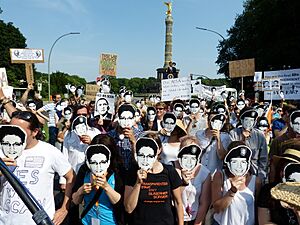
Encryption is a way to scramble data so that only the right people can read it. The NSA has worked to find ways to get around encryption. Sometimes, this means finding weaknesses in software. In other cases, the NSA might collect information before it gets encrypted or after it has been decrypted (unscrambled).
According to documents leaked in 2013, the NSA created a tool called XKeyscore. This tool allowed analysts to search through huge databases of internet activity, including emails, browsing history, and online chats.
Hacking Operations
The NSA has a special group called Tailored Access Operations (TAO). This group's job is to hack into foreign computer systems to gather intelligence. According to some reports, TAO has been very successful at getting information from countries like China.
The NSA has also been known to intercept computer hardware, like routers and servers, while they are being shipped. They install secret spying tools on the hardware before it reaches its destination. This allows the NSA to access computer networks around the world.
Domestic Collection
The NSA's mission is supposed to focus on foreign intelligence. Spying on American citizens inside the U.S. is limited by the Fourth Amendment to the U.S. Constitution, which protects against "unreasonable searches." However, after the 9/11 attacks, President George W. Bush secretly authorized the NSA to monitor the international phone calls and emails of people inside the U.S. without a warrant. This was known as the warrantless surveillance program.
The PRISM Program
One of the most famous NSA programs revealed by Edward Snowden was PRISM. Under this program, the NSA collected user data from major internet companies like Google, Facebook, and Apple. The data included emails, photos, videos, and online chats of foreign targets. The program was controversial because it sometimes collected the data of Americans who were communicating with people overseas.
The 2013 Global Surveillance Disclosures
In June 2013, a former NSA contractor named Edward Snowden leaked thousands of classified documents to journalists. These documents revealed the massive scale of the NSA's spying activities.
The leaks showed that the NSA was collecting the phone records of millions of Americans. They also revealed programs like PRISM and XKeyscore. The disclosures sparked a worldwide debate about privacy and government surveillance. Some people called Snowden a hero for revealing what the government was doing, while others called him a traitor for leaking national secrets. In 2020, a U.S. court ruled that the NSA's program to collect phone records was unlawful.
Where the NSA Works
Headquarters at Fort Meade
The NSA's main headquarters is located at Fort Meade, a large army base in Maryland. The main building is a huge, modern structure covered in dark glass. The glass is lined with copper to prevent electronic eavesdropping. The complex is so large that the U.S. Capitol building could fit inside it four times.
The headquarters has its own power plant, police force, and fire department. It is one of the most secure and secret places in the United States.
The Utah Data Center
To store all the information it collects, the NSA built a massive data center in Camp Williams, Utah. The Utah Data Center cost over $1.5 billion to build. It is designed to hold yottabytes of data (a yottabyte is one trillion terabytes). The facility uses a huge amount of electricity, enough to power a small city.
Global Stations
The NSA also has listening posts all over the world. It works closely with its "Five Eyes" partners and has stations in countries like the United Kingdom, Australia, and Germany. One of the largest is RAF Menwith Hill in England, which is filled with large, white domes called radomes that protect satellite dishes.
Controversy and Debate
The NSA's work has always been controversial. The main debate is about finding the right balance between keeping the country safe and protecting people's privacy.
Supporters of the NSA say that its surveillance programs are necessary to stop terrorist attacks and protect national security. They argue that in a dangerous world, the government needs these tools to find threats before they happen.
Critics, however, argue that the NSA's mass surveillance goes too far. They say that collecting the data of millions of innocent people is a violation of the right to privacy. Groups like the American Civil Liberties Union (ACLU) and the Electronic Frontier Foundation (EFF) have challenged the NSA's programs in court.
The debate over the NSA's role continues today, as technology changes and new threats emerge. Finding the right balance between security and liberty remains one of the biggest challenges for the U.S. government and its citizens.
- Australian Signals Directorate (ASD) – Australia
- Criticomm
- FAPSI – Russia (1991–2003)
- Garda National Surveillance Unit (NSU) – Ireland
- GCHQ – United Kingdom
- Ghidra (software)
- Internal Security Department (Singapore) (ISD) – Singapore
- Korean Air Lines Flight 007
- Harold T. Martin III
- List of NSA controversies
- Mass surveillance in the United Kingdom
- Ministry of State Security (Stasi) – former German Democratic Republic
- Ministry of State Security (China) (MSS) – China
- National Intelligence Priorities Framework
- National Technical Research Organisation (NTRO) – India
- Operation Ivy Bells
- Operation Eikonal
- Special Communications Service of Russia (Spetssvyaz) – Russia
- Unit 8200—Israel's equivalent to the NSA
- U.S. Department of Defense Strategy for Operating in Cyberspace
- Military Cryptanalytics
See also
 In Spanish: Agencia de Seguridad Nacional para niños
In Spanish: Agencia de Seguridad Nacional para niños


